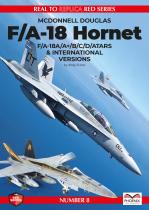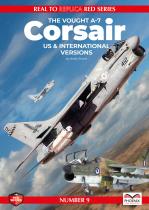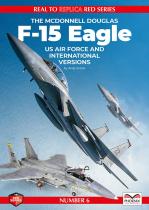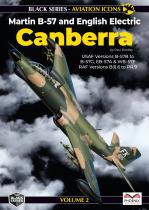This is the first in our new Black Series of reference titles. The English Electric Canberra is one of the classics of aviation history – a simple, yet highly effective design, adaptable to many roles and built in large numbers for service at home and an export success. Who could have seen when the prototype first flew in 1949 that the type would be in frontline service with the RAF for fifty-seven years? The Canberra was developed by English Electric during the mid- to late 1940s in response to a 1944 Air Ministry requirement for a successor to the wartime de Havilland Mosquito fast bomber. Among the performance requirements for the type was an outstanding high-altitude bombing capability and high speed. These were partly accomplished by making use of newly developed jet-propulsion technology. When the Canberra was introduced to service with the Royal Air Force, the type's first operator, in May 1951, and it became the service's first jet-powered bomber. In February 1951, a Canberra set another world record when it became the first jet aircraft to make a nonstop transatlantic flight. Throughout most of the 1950s, the Canberra could fly at a higher altitude than any other aircraft in the world, and in 1957, a Canberra established a world altitude record of 70,310 feet (21,430 m). Due to its ability to evade the early jet interceptor aircraft, and its significant performance advancement over contemporary piston-engined bombers, the Canberra became a popular aircraft on the export market, being procured for service in the air forces of many nations both inside and outside of the Commonwealth of Nations. The type was also license-produced in Australia by Government Aircraft Factories (GAF) and in the US by Martin as the B-57 Canberra. The latter produced both the slightly modified B-57A Canberra and the significantly updated B-57B. In addition to being a tactical nuclear strike aircraft, the Canberra proved to be highly adaptable, serving in varied roles such as tactical bombing and photographic and electronic reconnaissance. Canberra’s served throughout the Cold War, in the Suez Crisis, Vietnam War, Falklands War, Indo-Pakistani wars, and numerous African conflicts. In several wars, each of the opposing sides had Canberra’s in its air force. In June 2006, the RAF retired the last three of its Canberra’s. Three of the Martin B-57 variant remain in service, performing meteorological and re-entry tracking work for NASA, as well as providing electronic communication (Battlefield Airborne Communications Node) testing for deployment to Afghanistan. The Canberra story is long and complex, and a book of this size cannot hope to fully, or deeply cover it all. So, in an effort to do better justice to the type, we have split the history into two volumes. This book charts the story of the British bomber and trainer marks, while Volume 2 will cover the Interdictor, PR and export Canberras. We hope this book and its companion will present a compact and useful introduction to the type for both aviation enthusiasts and modellers. The Black however, series has a unique twist, in that although in our other titles we have a dedicated modelling section, this series does not. Or does it? Well, just like in our F-35 Blue Series title, the last page of the book contains a QR code that will take you to our website where you will find a modelling section that will be updated as new kits become available.









